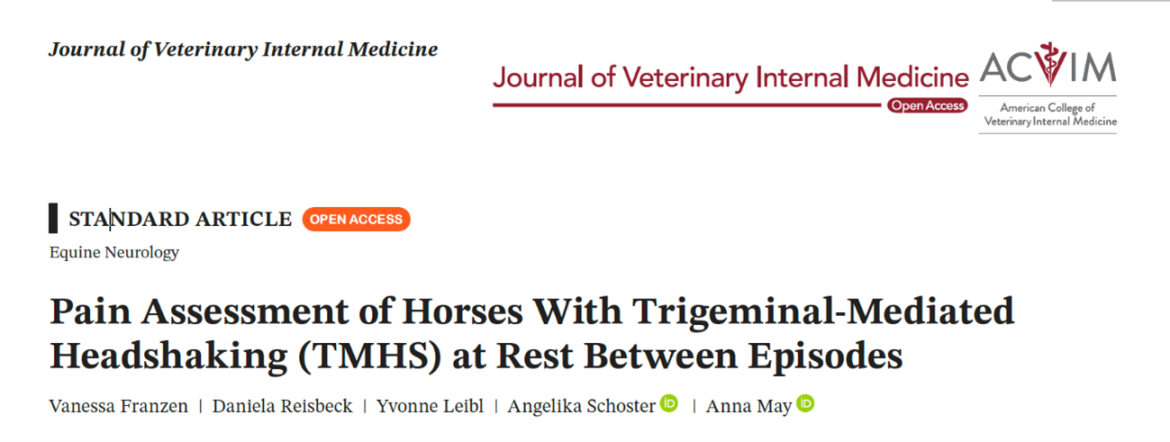
Science Newsletter Nº4 August 2025
Summary
This edition highlights recent European studies that provide new insights into equine veterinary medicine. The featured articles cover a range of disciplines, including ophthalmology, dermatology, neurology, gastrointestinal diseases, and sports medicine. Topics include clinical features and prognosis of immune-mediated keratitis, evaluation of oral treatments for sarcoids, novel therapies for trigeminal-mediated headshaking, welfare assessment in horses with neuropathic pain, risk factors and survival in acute gastrointestinal conditions, and diagnostics and recovery in asthma and athletic performance. These findings offer practical guidance and fresh perspectives for equine practitioners in their daily work.
In this edition’s "Do you know…" we get to know Emmanuell van Erk.
Read the article
OPHTHALMOLOGY

In this large case series, specialists from the Royal Veterinary College and the University of Helsinki investigated the clinical features and outcomes of 94 cases of equine immune-mediated keratitis (IMMK) within Europe. The clinical features and prognosis were similar between these two European centres, with anterior stromal keratitis being the predominant IMMK-subtype. Compared to the clinical features of IMMK previously reported in North America, the authors reported a higher incidence of blepharospasm, corneal ulceration and uveitis within the European cohort. Further, that horses presenting with blepharospasm or signs of uveitis were more likely to require enucleation, however none of the clinical features impacted the duration of treatment.
https://doi.org/10.1111/evj.14213
DERMATOLOGY

This multidisciplinary-led study was carried out by specialists from various academic and research institutions in Switzerland and Germany. A randomised, placebo-controlled trial evaluated oral Viscum album extract (VAE) as a treatment for equine sarcoids in 45 horses. There was no statistically significant difference in lesion regression between oral VAE treatment and placebo-treatment groups, although complete regression occurred in 27% of the oral VAE treatment group compared to 13% in the placebo treatment group. Oral VAE was well tolerated, but its clinical benefit remains unproven.
https://doi.org/10.1111/jvim.17052
NEUROLOGY

This observational cohort study, produced by colleagues from the University of Munich, described the outcome of repetitive transcranial magnetic stimulation (rTMS) treatment of 17 horses with trigeminal-mediated headshaking (TMHS). Statistical analysis revealed a significant reduction in headshaking signs after five consecutive days of treatment and a 50% reduction in headshaking behaviour four weeks later. The rTMS treatment was well tolerated and showed promise as a therapy for neuropathic facial pain in horses, although further studies are needed.
https://doi.org/10.1111/jvim.17194

The same research team as the previous article published this second study on trigeminal-mediated headshaking (TMHS), this time addressing it from the perspective of equine welfare. The Horse Grimace Scale (HGS) was used to assess pain in 20 TMHS horses, compared to healthy horses and horses experiencing moderate colic. The HGS pain score for TMHS horses was higher than healthy controls but lower than colic cases. It also showed that TMHS-affected horses experience significant discomfort during the interval between active headshaking episodes. This study indicates that TMHS negatively affects quality of life beyond overt episodes of headshaking behaviour.
https://doi.org/10.1111/jvim.70064
GASTROINTESTINAL

This retrospective study, led by a colleague from the University of Nantes, investigated the clinical features and factors affecting the survival of 25 horses with acorn intoxication-related colitis. Predominant clinical features included circulatory shock, gastrointestinal symptoms, and elevated renal/hepatic markers. Survival was reported as 44%, and most non-survivors died within 48 hours. Factors associated with poor prognosis included older age, tachycardia, haemorrhagic diarrhoea, elevated hematocrit and creatinine values, and thickening of the colon wall.
https://doi.org/10.3390/ani14040599

This study, conducted by colleagues from Utrecht University, explored the relationship between histopathological changes and prognosis in horses affected by inflammatory bowel disease (IBD). In 149 horses with histologically confirmed IBD of the duodenum, the most common clinical signs were weight loss and reduced performance. The predominant form was lymphoplasmacytic enteritis. The severity of the histological findings did not reliably predict outcome. The majority of cases demonstrated clinical improvement following corticosteroid treatment and clinical improvement by six weeks of treatment was associated with improved one-year survival rates.
https://doi.org/10.3390/ani14111638

The team of internists from the University of New Zealand continues their research into EGUS, this time in collaboration with the team at The Hong Kong Jockey Club and staff from the Department of Agriculture, Fisheries and Forestry in Canberra, Australia. This study compared two ELISA kits against a radioimmunoassay (RIA) measuring serum gastrin in horses. Both ELISA methods showed poor correlation with RIA, with high variability and bias, indicating they are not reliable alternatives. The use of non-validated ELISA assays for equine gastrin is not recommended.
https://doi.org/10.3390/ani14202937
SPORTS MEDICINE

The team from the University of Bern, Switzerland, continues their research into equine asthma in this new study. The effects of equine asthma on exercise recovery were studied in 37 horses. Asthmatic horses had delayed respiratory rate recovery after a 15-minute lunging test, with recovery linked to airway neutrophilia and exercise speed. Heart rate recovery was better in younger and better-trained horses. Monitoring RR post-exercise may help detect functional deficits in asthmatic horses.
https://doi.org/10.3390/ani15050713

This retrospective observational study was the result of a collaborative effort between the University of Nottingham (UK), technology solutions company ARIONEO and Equine Sports Medicine Practice (Belgium). Fitness trackers were fitted to 485 flat racehorses in training in Australia, in order to obtain exercising speed data during fast training sessions and post-exercise heart rate recovery data. Subsequent race results were extracted from the Racing Post website and logistic regression analysis was used to determine whether exercising speed during training or post-training heart rate recovery might be predictive of race-day performance.
Greater finishing speed over the last 600m distance of a benchmark training distance was associated with better race outcomes, especially in colts and stayers. However, pinpoint exercising speed at 600m of 1km distance, and post-exercise heart rate recovery were not associated with improved race outcomes. These findings may be useful to trainers in assessing race potential.
https://doi.org/10.3390/ani14091342